Flox den Hartog Jager: Angels and demons in stitch and print
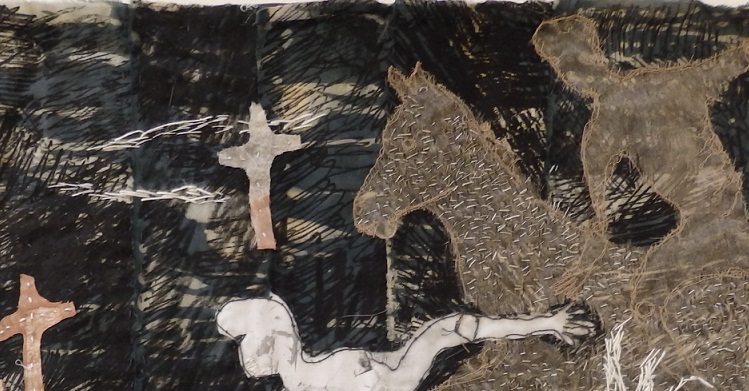
Like many who pick up a needle and thread, Flox den Hartog Jager was introduced to the practical side of stitch from quite a young age. However, she insists it was her mother’s intellectual pursuit of studying symbols, religion and mythology that has had the greatest influence on her work.
Flox is above all a storyteller. And to that end, she uses fabric manipulation and stitch to create metaphorical interpretations of angels, demons, and Apocalyptic motifs. She preps her fabrics with a variety of techniques, especially monoprinting and resist. And she uses stencils and hand embroidery to create mythical visual tales.
In this article, you will discover how her journey has gone from a gift of fabric patches to becoming a world-renowned textile artist. You’ll also discover specific tips on how to create texture in your fabrics by using monoprinting in an unusual way, as well as using wax and flour resists.
Flox is a member of the Dutch textile group StiQS and the 62Group. She is also the organizer of textile art exhibitions and Masterclasses every three or four years in an old cloister in Biezenmortel. Flox has written 30 articles for the Dutch Quilter Guild Magazine, some of which were published in Germany and Denmark.
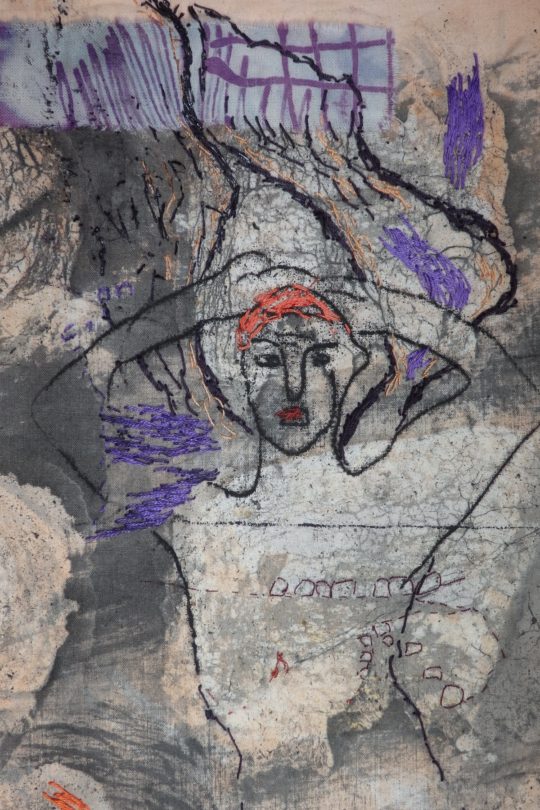
Flox den Hartog Jager: Sixth Night, 2011, Rusted and dyed cotton, monoprinted and hand embroidered
A rag woman’s gift
TextileArtist.org: What initially attracted you to textiles as a medium? How was your imagination captured?
Flox den Hartog Jager: I started working with textiles when I inherited my mother-in-law’s patches in the late 1990s. She was so fond of textiles that she could not go to the market without buying a piece of cloth. We called her a real “lappenvrouw” which means “rag woman” in Dutch.
I started using the patches to make patchwork blankets for my children and nieces after seeing a great exposition of quilts at The Hague. I instantly liked the abstract geometrical patterns.
But I found making quilts was boring and time-consuming. And the results were so different from what I imagined. Instead of neat and precise designs, my blankets were higgledy-piggledy. And no matter how much I practised, they never got better.
But I liked the material, especially its softness, tactility, and the fact it was rather easy to work with.
I also became a member of the Dutch Quilters Guild, but I started without having taken any lessons.
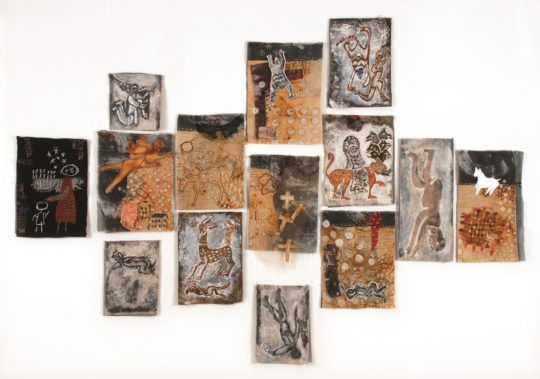
Flox den Hartog Jager: Seven to twelve, 2016, Cotton, Organza, wax resist, flour paste resist, gesso resist, inks, hand and machine embroidery
What or who were your early influences and how has your life/upbringing influenced your work?
My father was an important influence on my creativity. When I was small, he bought kits to make little crafty presents. A paper lantern for Christmas, wooden candles and paint for decorating, enamel powder and copper plates to make brooches, and an embroidery kit I never completed.
Of course, in primary school, I also learned textile techniques a housewife was supposed to know: knitting (my socks never matched in size), crocheting, mending and darning knitted clothes, embroidery, and sewing.
And my mother bought me a sewing machine when I started living on my own as a student. She thought that was a practical thing to have. It stayed in the closet for many years.
But the most important influence of my upbringing and education was intellectual, not practical. My mother started studying symbols, religions, myths and legends when we children left the house. She used to tell us about all she had read. She had a phenomenal knowledge. Her favourite scientist was Joseph Campbell.
During that time, I had started studying philosophy and history myself, so I enjoyed listening to her. So her way of analysing and interpreting the meaning of life has had a lasting influence on all of us children.
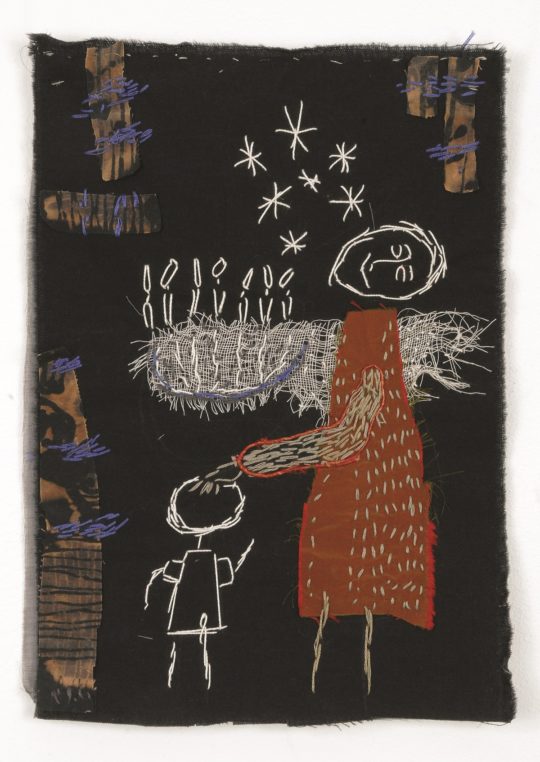
Flox den Hartog Jager: Son of Man (Detail of Seven to Twelve), 2016, Cotton, discharged resist, hand embroidery
What was your route to becoming an artist?
Directly after realizing making quilts was not my cup of tea, I found a course that was meant to explore personal creativity by using old textile techniques. It was started by Hanny Spierenburg, Advisor of Textiles at the Institute of Amateur Art in the Netherlands. It was a two-year course, and I loved it.
I started experimenting with the material and wrote articles about my experiments for the Dutch Quilters Guild’s magazine. I also took drawing lessons, because I thought it was important to make a good composition.
I also still keep reading about making art. My intellectual side needs feeding every now and then. I discovered art can be looked at from many perspectives, and that made me understand it better.
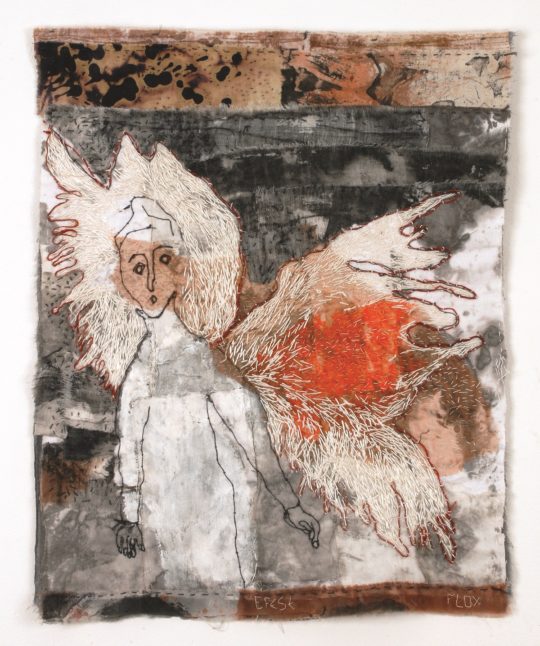
Flox den Hartog Jager: Efese, 2016, Cotton, organza, monoprint, discharged resist, hand embroidery
I love the accidents that always happen
Tell us about your process from conception to creation
I am a storyteller. The story is most important to me, so I read, I think, and I look at the ways other artists have imagined and developed a theme. I try to find more layers of meaning.
I mostly draw and monoprint to develop the images that go with my story, making them sharper and more focused on precisely what I wish to tell. Monoprinting makes me feel freer than drawing with a pencil.
I work very fast and make lots of prints, usually no bigger than A4 or A3.
To transfer my drawing onto the cloth, I enlarge my drawings according to the size I need on a new sheet of paper and create a kind of stencil. I use and re-use them in my work, making the stencils bigger, smaller, whatever is needed for a particular piece.
When I like an image, I start making a background mostly with thin white ink-stained muslin. I then pin the paper stencils on the cloth and hand embroider freely around them.
Once the main part of the work is embroidered, I start with this surroundings. For this, I have a pile of pieces of textile that I worked on before using monoprint, discharge, resist, screenprint, batik, etc. I try to find pieces that match the atmosphere and composition.
And I love the accidents that always happen in the process.
For example, monoprinting usually involves inking a plate, drawing or making some other marks in the ink, and then placing paper or cloth on top of the plate and softly rubbing to help the paper or fabric absorb the ink. I like to instead place my cloth on the inked plate first, and then I start drawing on the back of the cloth.
One of my happiest monoprinting accidents relates to my piece “The Devil, the False Prophet and the Beast.” I had been printing on a piece of cloth that was twice the size of the plate in an attempt to make one big piece of art.
However, I soon realized what was happening on my plate was more interesting than what was happening on the cloth! The two drawings had become intertwined on the plate in which the feet of the prophet start at his chest, and the best lost his body and was flattened.
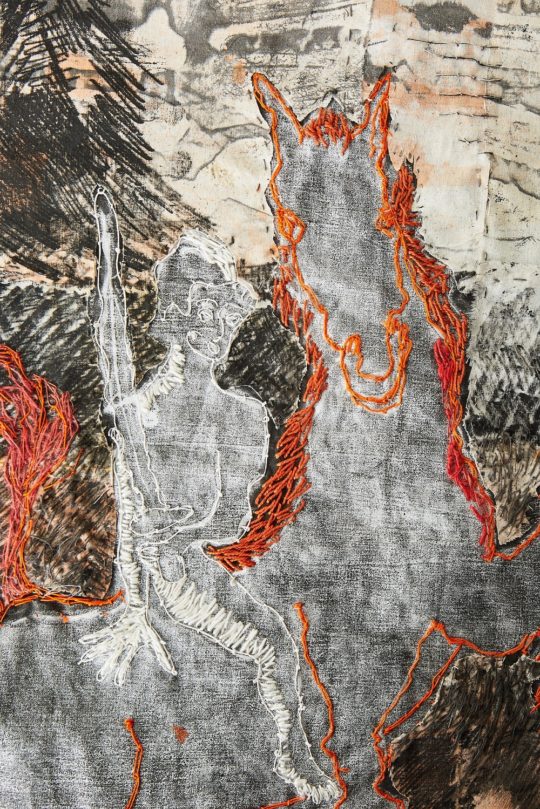
Flox den Hartog Jager: The Four Riders: Red (Detail), 2017, Cotton, flour paste resist, monoprint, hand embroidery
Tell us a bit about your chosen techniques and how you use them
I like to work my textiles first with all kinds of techniques and materials: resist with wax, gesso, flour paste, discharge, monoprinting in many ways, or just plain staining fabric with inks.
To give my textiles texture, I especially like resist techniques. Of course, I do batik with wax, which results in white lines on a coloured piece of cloth. But I also use a technique Dorothy Caldwell has advanced that combines a resist technique with a discharge.
She starts with a black or coloured piece of cloth using wax for resist and a discharge to remove colour from the cloth. The result is beautiful small black or coloured lines on a white piece of cloth.
Using this technique next to traditional batik allows me to make positives and negatives.
Because I like to work with simple things, I also use flour paste resist a lot. I mix flour with water until I get a yoghurt-like consistency. I then paint the paste onto the fabric, let it dry very, very well, and then use inks to paint over the paste.
Where wax gives nice fine lines, the flour paste is coarser and much easier to wash than wax.
I describe the difference between wax and flour in this way: I associate wax with Indonesia and flour paste with Africa.
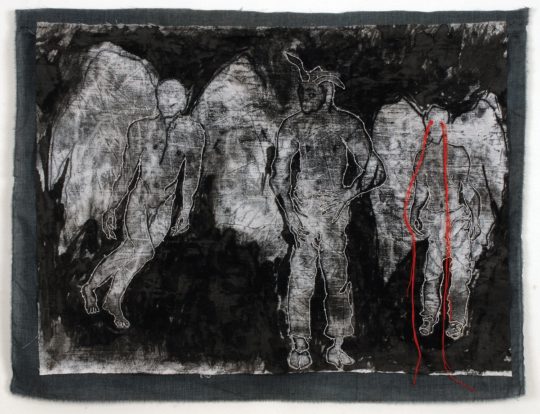
Flox den Hartog Jager: Their King was the Angel of the subterranean Depth, 2017, Cotton, Monoprint, Inks, Hand Embroidery
What currently inspires you?
I have been working on angels and devils for a long time. The angels were there from the start, but the devils started to come into being when I took the Apocalypse as my theme.
The Apocalypse tells a story of violence through various battles, volcanoes, earthquakes and more. In 2014, I associated current events such as the activities of ISIS to found an Islamic Caliphate and the uprising against the Turkish Erdogan to the Apocalypse, and my work seemed to merge with history in the making.
But the violence in the Apocalypse is not without meaning. It has a purpose to clear the world of all even as preparation of a new beginning—the new Jerusalem.
In addition, the angels and devils are not meant to represent good and bad, because they don’t live in a moral world. Their world is more abstract and mythological. They show how creation relies upon opposites: white and black, young and old, good and bad, or what is now and what can be imagined. Nothing will come about when there are no opposites.
The angels represent “what is,” while the devils show “what can be” by stepping away from what is. When studying philosophy, I explored Utopia and liked the idea that it starts with the “world that is” and then imagines a world that transcends that world.
On the BBC’s Facebook page, a British actor referred to the podcasts of Michael Meade, who explains what happens in the world in this mythological way. I looked them up and listened with fascination. It was as if I was hearing my mother tell the stories – www.livingmyth.org
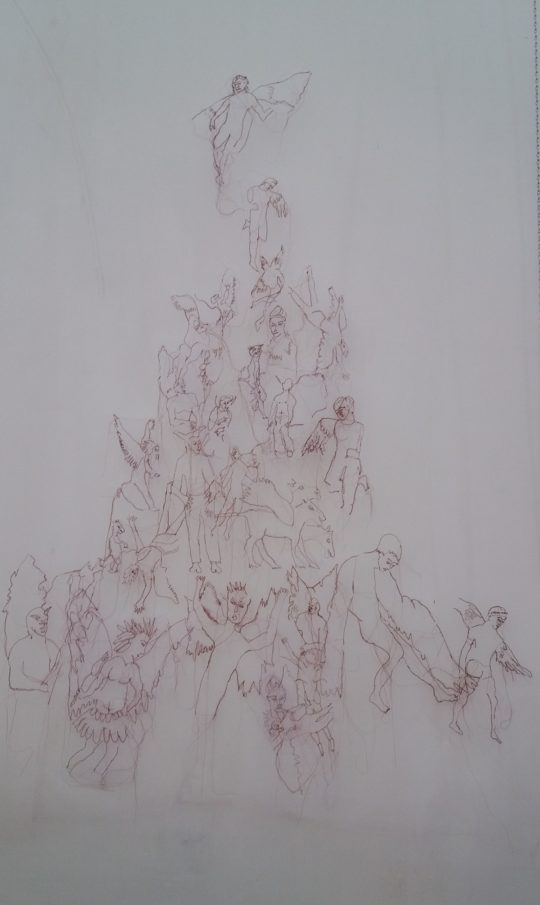
Flox den Hartog Jager: Stairway to Heaven III, 2018, Tulle, Machine Embroidery
I don’t have a plan, and that’s exciting
Tell us about a piece of your work that holds particularly fond memories and why?
Though I can’t say I have “fond” memories of my works, there are two that I cherish. I made them after hearing my husband was ill and was going to die.
One is “The Ferryman” on whose boat the dead will pass the river Styx. The other is called “Stairway to Heaven” which is a large work with angels and devils going up and down.
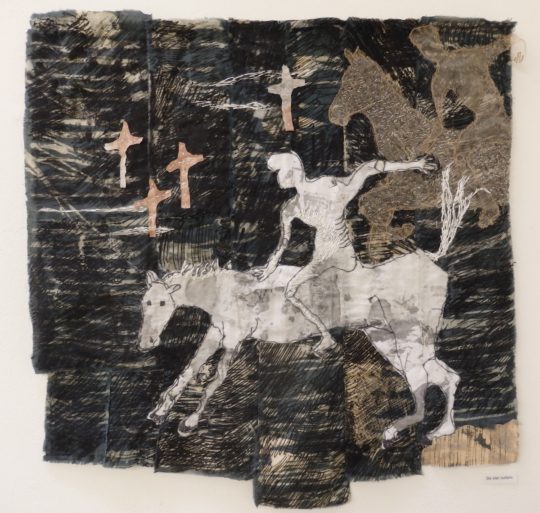
Flox den Hartog Jager: The Four Riders: Death, 2017, Cotton, Organza, Monoprint, Hand Embroidery
How has your work developed since you began and how do you see it evolving in the future?
My development has been from quilting, and later art quilting, to textiles in general and more particularly to hand embroidery. But now I will need to learn how to embroider by machine because my hands have much osteoarthritis which makes it more and more impossible to work by hand.
The stories will stay, but I notice new symbols coming in and mingling with symbols of different worlds.
I don’t have a plan, and that’s why I am quite excited about what my hands will decide to be the next step.
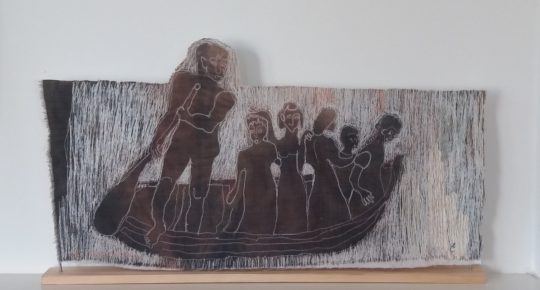
Flox den Hartog Jager: The Ferryman, 2018, Hand dyed cotton and machine embroidery
What advice would you give to an aspiring textile artist?
I still meet up with my classmates every two months. We discuss our work under the supervision of a teacher. The different views they have on your work sharpen your mind, the way you think and open your eyes, for what lies behind the borders you created yourself. And if necessary they will push you gently to cross them.
So I think it’s important to gain feedback from others, especially those who will be both honest and supportive.
For more information visit www.floxdenhartogjager.nl
Flox shared a variety of techniques, especially related to use of monoprinting and resist techniques. Do you use either technique in your own work? We’d love to hear about your experiences by posting a comment below.
















Thank you for sending these interviews. This one is so interesting about using storytelling. I use myths and stories in my dance teaching and have recently made a hanging based on a Greek myth. Seeing Flox’s work which is so different to mine has given me inspiration to make more story based pieces.
Wendy, i am very interested in the work you will make!
Incredible work! Thank you for sharing. Flox’s work is tremendously inspiring.
amazing work, very deep and strikingly achieved.
Thank you Flox, for sharing you working method and ‘the interesting devil and angel story’. But also the great adventure of being an artist. Thanks for this ‘kijkje in jouw keuken’!
I so enjoy reading about how the Art’s are combined with the textiles to produce fantastic works of expression. There is nothing more pleasing than opening one’s mind to creative instinct provided by others and then see it come to life in your own hands.